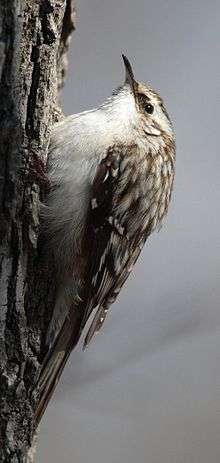Brown creeper
| Brown creeper | |
|---|---|
 | |
| | |
| Scientific classification | |
| Kingdom: | Animalia |
| Phylum: | Chordata |
| Class: | Aves |
| Order: | Passeriformes |
| Family: | Certhiidae |
| Genus: | Certhia |
| Species: | C. americana |
| Binomial name | |
| Certhia americana Bonaparte, 1838 | |
- For the similarly named Australian bird see Brown treecreeper.
- For the similarly named New Zealand bird see Brown creeper (New Zealand).
The brown creeper (Certhia americana), also known as the American treecreeper, is a small songbird, the only North American member of the treecreeper family Certhiidae.
Description
Adults are brown on the upper parts with light spotting, resembling a piece of tree bark, with white underparts. They have a long thin bill with a slight downward curve and a long stiff tail used for support as the bird creeps upwards. The male creeper has a slightly larger bill than the female. The brown creeper is 11.7–13.5 cm (4.6–5.3 in) long.
Its voice includes single very high pitched, short, often insistent, piercing calls; see, or swee. The song often has a cadence like; pee pee willow wee or see tidle swee, with notes similar to the calls.
Distribution, habitat and range
Their breeding habitat is mature forests, especially conifers, in Canada, Alaska and the northeastern and western United States. They are permanent residents through much of their range; many northern birds migrate farther south to the United States. Brown creeper has occurred as a vagrant to Bermuda and Central America's mountains in Guatemala, Honduras and the northern cordillera of El Salvador. As a migratory species with a northern range, this species is a conceivable vagrant to western Europe. However, it is intermediate in its characteristics between common treecreeper and short-toed treecreeper, and has sometimes in the past been considered a subspecies of the former, although its closest relative seems to be the latter (Tietze et al., 2006). Since the two European treecreepers are themselves among the most difficult species on that continent to distinguish from each other, a brown creeper would probably not even be suspected, other than on a treeless western island, and would be difficult to verify even then.
Brown Creepers prefer mature, moist, coniferous forests or mixed coniferous/deciduous forests. They are found in drier forests as well, including Engelman Spruce and larch forest in eastern Washington. They generally avoid the rainforest of the outer coast. While they generally nest in hardwoods, conifers are preferred for foraging.
Subspecies
- Northern Group [2]
- Brown Creeper (C.a. alascensis)
- Brown Creeper (C.a. americana)
- Brown Creeper (C.a. leucosticta)
- Brown Creeper (C.a. montana)
- Brown Creeper (C.a. nigrescens)
- Brown Creeper (C.a. occidentalis)
- Brown Creeper (C.a. phillipsi)
- Brown Creeper (C.a. stewarti)
- Brown Creeper (C.a. zelotes)
- Southern Group
- Brown Creeper (C.a. alticola)
- Brown Creeper (C.a. guerrerensis)
- Brown Creeper (C.a. jaliscensis)
- Guatemalan Brown Creeper (C.a. pernigra)
- Honduran Brown Creeper (C.a. extima)
- Mexican Brown Creeper (C.a. albescens)
Conservation status
As with many of Washington's birds, the Cascades divide this species into two subspecies. The species has declined in much of North America but appears to be doing well in Washington, with a small (not significant) increase on the state's breeding bird survey since 1966.
Behaviour
They forage on tree trunks and branches, typically spiraling upwards from the bottom of a tree trunk, and then flying down to the bottom of another tree. They creep slowly with their body flattened against the bark, probing with their beak for insects. They will rarely feed on the ground. They mainly eat small arthropods found in the bark, but sometimes they will eat seeds in winter.
Breeding
Breeding season typically begins in April. The female will make a partial cup nest either under a piece of bark partially detached from the tree, or in a tree cavity. It will lay 3–7 eggs, and incubation lasts approximately two weeks. Both of the parents help feed the chicks.
Gallery
 A creeper at Great Falls, MD, USA
A creeper at Great Falls, MD, USA Brown creeper spiraling in Biddeford, ME
Brown creeper spiraling in Biddeford, ME.jpg) In Coastal Southern Alaska
In Coastal Southern Alaska.jpg) In Ontario, Canada
In Ontario, Canada
References
- ↑ BirdLife International (2012). "Certhia americana". IUCN Red List of Threatened Species. Version 2013.2. International Union for Conservation of Nature. Retrieved 26 November 2013.
- ↑ https://species.wikimedia.org/wiki/Certhia_americana
Further reading
- Tietze, Dieter Thomas; Martens, Jochen & Sun, Yue-Hua (2006). "Molecular phylogeny of treecreepers (Certhia) detects hidden diversity". Ibis. 148 (3): 477–488. doi:10.1111/j.1474-919X.2006.00547.x.
- Thurber, Walter A. (1978). Cien Aves de El Salvador. San Salvador: Ministerio de Educación.
- Yurgenson A. : birds.cornell.edu
External links
| Wikimedia Commons has media related to Brown Creeper. |
| Wikispecies has information related to: Certhia americana |
- Brown Creeper - Certhia americana - USGS Patuxent Bird Identification InfoCenter
- Brown Creeper Species Account - Cornell Lab of Ornithology
- Brown creeper species account - Animal diversity web
- "American Treecreeper media". Internet Bird Collection.
- Brown Creeper photo gallery at VIREO (Drexel University)
- Interactive range map of Certhia americana at IUCN Red List maps
